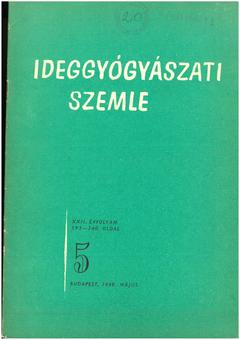The eLitMed.hu medical portal uses computer cookies for convenient operation. Detailed information can be found in the Cookie-policy.
Clinical Neuroscience - 1969;22(05)
Content
[Three cases of juvenile pseudomyopathy of spinal muscular atrophy (Kugelberg-Welander type)]
[The author described a juvenile pseudomyopathic (Kugelberg-Welander) form of spinal muscular atrophy (SI) in 3 cases. Juvenile SI can be differentiated from progressive dystrophia musculorum by the presence of muscle fasciculopathies and neurogenic EMG and muscle biopsy findings. The recognition of pseudomyopathic SI is of practical importance because of its much better prognosis than muscular dystrophy. Kugelberg-Welander juvenile and Werdnig-Hoffmann infantile SI cannot be considered as separate genetic types. In our case 2, SI started at the age of 11 years. In the muscle biopsy at 14 years of age, in addition to neurogenic atrophy, we found so-called myopathic lesions and lymphorrhagia. The relationship between these three types of pathophysiological syndromes is left to conjecture. Primary muscle lesions are considered to be independent of SI. The latter, i.e. lymphorrhagias and muscle fibre degeneration, may have a common (autoimmune?) pathomechanism. In our second case, during the 4-year follow-up, physiotherapy and exercise resulted in an increase in muscle strength instead of the previous permanent decrease in muscle strength. In our 3rd case, juvenile SI was associated with myositis. Presumably it was a coincidence of the two lesions. Author summarizes in a table the data used to distinguish between the ascending form of Kugelberg-Welander SI and dystrophia musculorum progressiva. ]
["Gangliocytoma" cerebelli ]
[We describe a rare case of a so-called "gangliocytoma cerebelli". We discuss the clinical picture and the possibilities of an effective surgical solution. Based on our pathological studies, we consider this lesion, which is still controversial in the literature, to be a hamartoblastoma. ]
[Types of thermal nystagmus induced in healthy individuals ]
[The author studied 71 healthy individuals with an electronystagmograph wall and the types of nystagmus induced by thermal stimulation. Five basic types were identified, as follows: 1. regular reactio, where the amplitude and frequency of nystagmus are moderate, 2. weak reactio, where the nystagmus strokes are rare and the amplitude is small. This group also includes fibrillation and floating movements of the eyeball. 3. large reactio, with a high frequency of nystagmus beats and a rapid frequency, 4. uneven reactio, the frequency and amplitude of the strokes are uneven, 5. clustering, in which the nystagmus is interrupted by pauses. The author considers it possible that by further study of the typus of the thermal nystagmus, useful information about the functional typus and the instantaneous state of the central nervous system can be obtained.]
[Tissue development of muscle spindles]
[We studied muscle spindles from fetuses and infants of different ages, from 2-month-old embryos to 6-month-old infants. Our observations are summarised below: 1. intrafusal fiber formation from the myotube stage begins in humans at embryonic month 2. 2. 3. The formation of nuclear sac fibres is initiated in the 3rd fetal month in connection with further proliferation and aggregation of the nuclei. 4. The connective tissue sheath of the muscle spindle begins to form in the 4th fetal month. 5. In the 6th fetal month, the innervational pattern of the muscle spindles corresponds to the so-called simpla muscle spindles. In the newborn, so-called "complex" muscle spindles are found, where the subnerual apparatus of the intrafusal fibres is also clearly visible. 7. Intrafusal fibres in foetus and infant have a larger diameter than extrafusal fibres. 8. In adult human muscle spindles, intrafusal fibres were found only under abnormal conditions.]
[Painful asymbolia]
[Our 13-year-old right-handed patient presented with the following symptoms after a left centroparietal regio lesion: right homonymous inferior quadrans hemianopia; right hemiparesis; right hemihypaesthesia and hemihypalgesia (needle prick was marked as sharp all over the body); amnestic aphasia; acalculia, alexia; constructive apraxia; painful (danger) asymbolia. In the face of painful stimuli, his vegetative reactions were preserved, his motor reactions were virtually absent, his behavioural responses were pale, his psychic reactions and experience were paradoxically ambivalent: the latter may be taken as the dominant symptom of pain asymbolia. Nor did the patient fully grasp the danger of the situation. The pain asymbolia appears to be a specific disorder of categorical behaviour; it is a local sign, indicating damage to the dominant parietal lobe.]
1.
Clinical Neuroscience
[Headache registry in Szeged: Experiences regarding to migraine patients]2.
Clinical Neuroscience
[The new target population of stroke awareness campaign: Kindergarten students ]3.
Clinical Neuroscience
Is there any difference in mortality rates of atrial fibrillation detected before or after ischemic stroke?4.
Clinical Neuroscience
Factors influencing the level of stigma in Parkinson’s disease in western Turkey5.
Clinical Neuroscience
[The effects of demographic and clinical factors on the severity of poststroke aphasia]1.
2.
Clinical Oncology
[Pancreatic cancer: ESMO Clinical Practice Guideline for diagnosis, treatment and follow-up]3.
Clinical Oncology
[Pharmacovigilance landscape – Lessons from the past and opportunities for future]4.
5.



